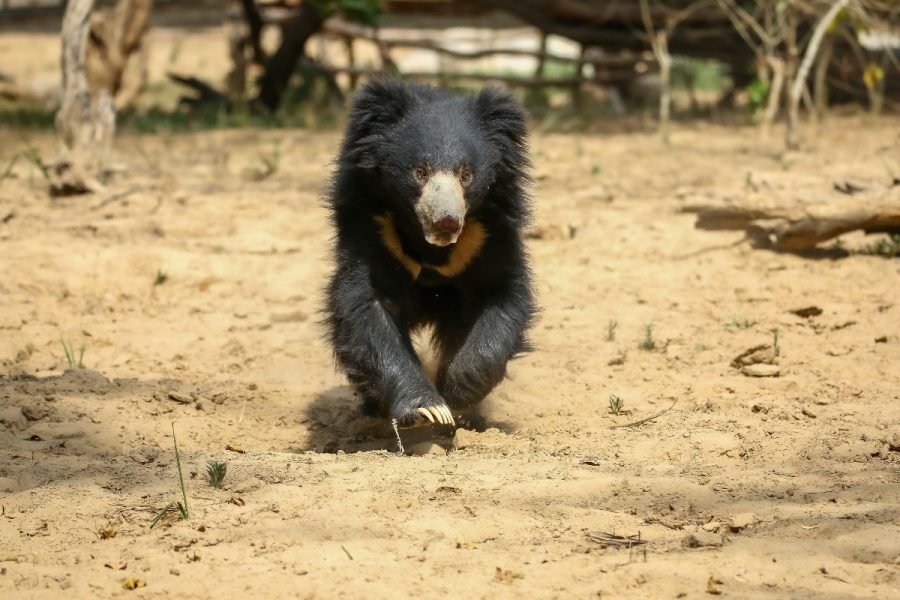From fairy tales like ‘Goldilocks and The Three Bears’ to stories like ‘The Jungle Book’, bears have made an appearance in literature and media throughout modern history. These are charismatic species and some of them are among the largest land animals on this planet. Today, we find a total of eight bear species in the world, out of which the Asiatic Black Bear, Himalayan Brown Bear, Sloth Bear and Sun Bear are found in India. Let’s take a deeper dive and get to know our Indian bears.

Asiatic Black Bear
The Asiatic black bear has seven subspecies, out of which we find the Himalayan Black Bear (Ursus thibetanus laniger) subspecies in India. If you ever spot a black bear in the wild and face difficulty identifying it, look for a pale yellow or whitish crescent moon-shaped patch on the chest which is its most distinguishable physical feature. The Asiatic black bear in this part of the world is spread across the Himalayas from Bhutan in the east to Pakistan in the west. In India, its range covers Arunachal Pradesh, Assam, Sikkim, and the union territory of Jammu and Kashmir (J&K).
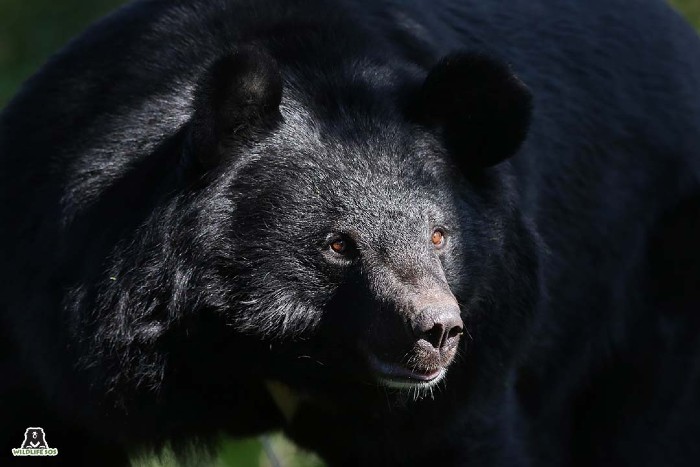
Black bears occupy a variety of habitats ranging from temperate broad-leaved and coniferous forests to alpine meadows. Black bears are omnivorous but a major part of their diet consists of fruits such as acorns, berries, cherries, peaches, apples as well as maize. These bears also have long claws which they use to find and eat termites.
Today, Asiatic Black Bears are threatened by a number of factors starting with climate change, habitat loss, habitat degradation and poaching for body parts. The loss of habitat is caused by expansion of human settlements, encroachment of wild places due to roadways, infrastructure projects and so on. In India, less than 10% of the species’ range is under Protected Areas (PAs) and areas outside PAs fall victim to developmental projects, and fuelwood and timber extraction. Moreover, they are hunted for their skins, paws and especially gall bladders, which usually have demands in traditional Chinese medicine.
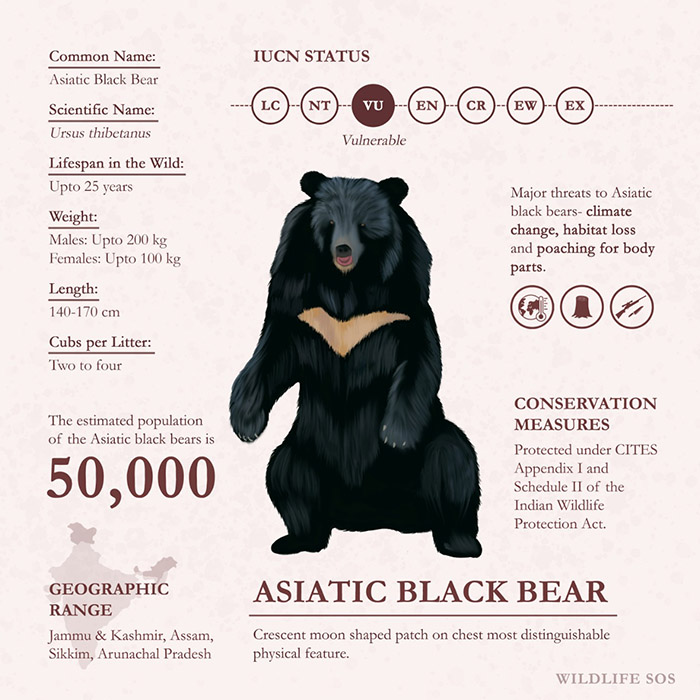
In terms of conservation measures, this species is protected under CITES (Convention on International Trade in Endangered Species of Wild Flora & Fauna) Appendix I and Schedule II of India’s Wildlife (Protection) Act, 1972. Wildlife SOS has been working for the conservation of Asiatic black bears in India for nearly 15 years. Our Dachigam and Pahalgam Rescue Centres in Jammu and Kashmir are home to 6 rescued and rehabilitated black bears. Wildlife SOS has not only rescued these bears from precarious situations, but also facilitated ex-situ conservation of this species by keeping them under captive care. It is no exaggeration to say that Wildlife SOS were the pioneers in mitigating man-bear conflict in J&K. One thing which we have focused on, is working on increasing people’s tolerance towards bears. Because of that a lot of youths volunteered to work with us, involving themselves in various programs and rescues.
Sloth Bear
Out of the four bear species found in India, Sloth Bears are the most ubiquitous and widespread. A significant part of the global sloth bear population is found in India, namely in the Western Ghats, Madhya Pradesh, Uttar Pradesh, Chhattisgarh, West Bengal and north-east India.
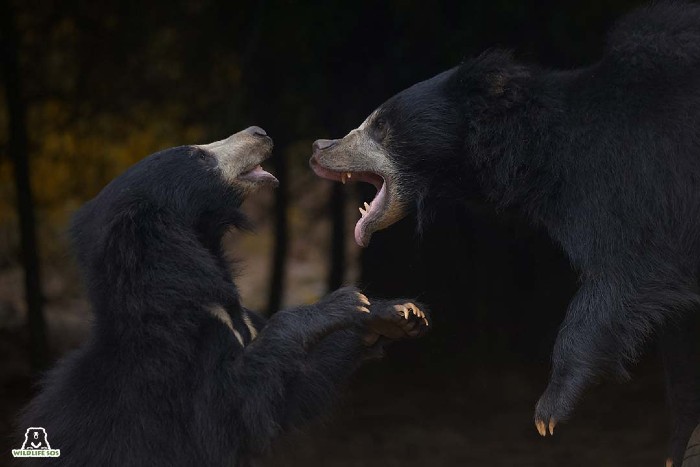
Sloth bears are indeed unique in terms of morphology and behaviour. The bear stands out because of its protruding muzzle, which is possibly the longest among all the bear species. Sloth bears give birth to a maximum of two cubs per litter and the cubs are seen riding on the mother’s backs, which is unique only to this particular species. Sloth bears are myrmecophagous, i.e half of their diet consists of ants and termites. That is why they have long claws to dig up termite mounds and have also lost their front teeth which helps them to suck up insects in an efficient manner.
Sloth bears face a lot of risks which include factors like human-wildlife conflict, habitat fragmentation, hunting and poaching. Earlier, the mother bears were killed so that poachers could sell their cubs to the nomadic tribe called the Kalandars. They were then eventually raised in captivity and used for entertainment purposes as part of this tribe’s 400-year-old ‘Dancing Bear’ tradition. Wildlife SOS has been working on sloth bear conservation for nearly 30 years and has eradicated this gruesome practice by freeing the last dancing bear in 2009.

Not only have we rescued and freed these bears, but also rehabilitated them. Currently, Wildlife SOS runs the largest and second-largest sloth bear rescue centers in the world, in Agra and Bangalore respectively. Wildlife SOS has also helped in providing alternative livelihoods to the rehabilitated Kalandars and mitigated man-sloth bear conflicts through rescue operations, awareness generation and capacity building across the southern, western and central Indian landscapes. Moreover, Wildlife SOS has also undertaken a first-of-its-kind sloth bear denning project. Studying the denning pattern ecology of wild sloth bears in their natural habitats, further helped us understand their physiology and natural behaviour.
Himalayan Brown Bear
There are as many as 15 subspecies of the Brown Bear, out of which we find the Himalayan Brown Bear (Ursus arctos isabellinus) subspecies in India. The Himalayan brown bear is categorised as Endangered in the IUCN Red List, most likely because its wild population is estimated to be around 500-700.
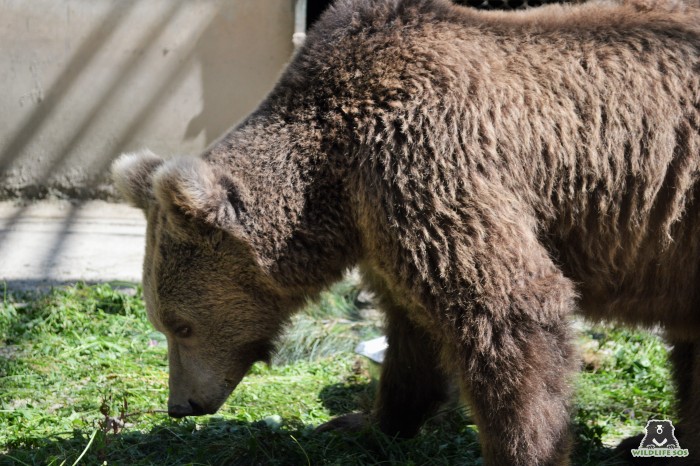
As is clear from their name, these bears have a thick fur which is mostly reddish-brown or sandy in colour. Himalayan brown bears are the heaviest and largest of the four bears, with weights reaching a maximum of 550 kg for males. This species is found in higher altitudes across north-western and central Himalayas including Afghanistan, Pakistan, India, Nepal, Tibet and west China. In India, they are only found in J&K, parts of Himachal Pradesh and northern Uttarakhand.
Himalayan brown bears are omnivorous, with their diet consisting of roots, grasses, insects and small mammals such as marmots and pikas. During autumn, they descend to lower altitudes to feed on fruits and berries. Sometimes they even become opportunistic feeders and take livestock such as sheep and goats when available. Brown bears are diurnal and generally solitary, except during mating and for mothers with cubs. These bears hibernate for the most part of winter and may lose upto one-third of their weight after emerging from hibernation.

Today, various hazards pose a threat to the Himalayan brown bears including climate change, habitat loss and man-bear conflicts. But these conflicts occur because their habitats are getting degraded and shrinking day by day. Since 2007, Wildlife SOS has been assisting the J&K Wildlife Protection Department in training workshops in all the divisions of Kashmir as part of capacity building of the department officials. We also conducted awareness programs on waste management since bears were spotted in human habitations, attracted by open dustbins. Lastly, Wildlife SOS also runs two facilities in Dachigam and Pahalgam, which is home to 2 brown bears.
Sun Bear
The Sun Bear is a very rare and elusive animal, and is only found in north-east India. Due to the limited research and study, its distribution in that region is not exactly known. However, sun bears are mostly found in the tropical evergreen forest habitat.
These bears are the smallest of all the eight species found and have short, sleek fur which is usually black, but occasionally reddish-brown or grey. Another stand out feature which can help one recognise a sun bear in the wild is the distinctive chest patch, which can be orange, yellow or white. Sun bears are omnivores, feeding primarily on ants, termites, bee larvae, beetle larvae, honey and a wide variety of fruits, especially figs. They have the longest tongue of all the bear species which helps them to feed on termites and ants.
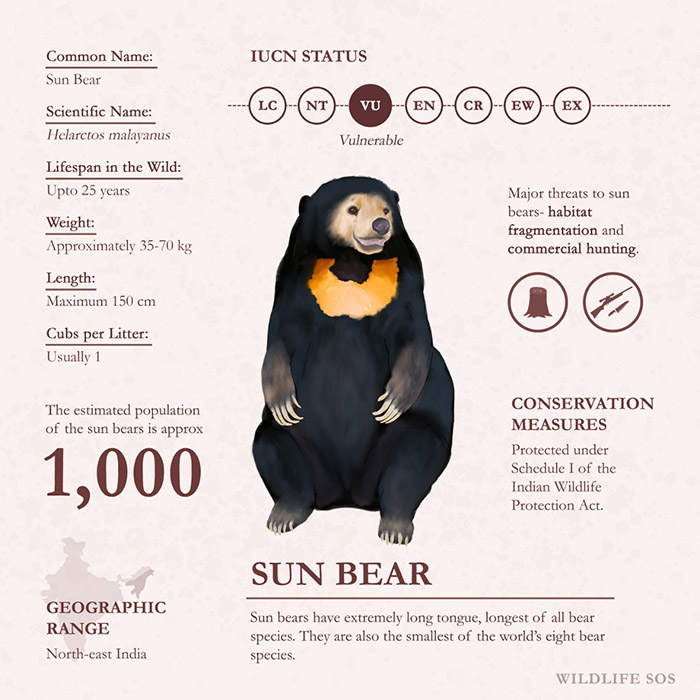
Even though sun bears are listed under CITES Appendix I, they do face a lot of threats, the major one being deforestation. Apart from that, they are often killed to prevent crop damage and for fear of bears near villages. Large-scale deforestation has dramatically reduced the suitable habitat of this species as well as habitat quality of the remaining forests. It is suspected that the global population of sun bears has drastically declined by 30% in the last three decades.
Thus, it is clear that all these four bear species are not completely exempt from human threats and need the attention of conservationists. Conservation of habitats, enforcing and implementing stricter laws to eliminate illegal trade of bear body parts and awareness generation are key to the protection of these precious animals. We have to work toward a future where this magnificent species can thrive and survive. To support the work that Wildlife SOS does for bear conservation, consider becoming a monthly donor or sponsor to support the upkeep of the rescued and rehabilitated bears.


